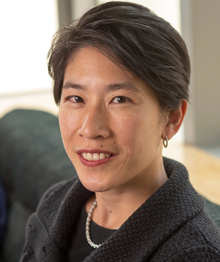Loading AI tools
American chemist and materials scientist From Wikipedia, the free encyclopedia
Teri W. Odom is an American chemist and materials scientist. She is the chair of the chemistry department, the Joan Husting Madden and William H. Madden, Jr. Professor of Chemistry, and a professor of materials science and engineering at Northwestern University.[2][3] She is affiliated with the university's International Institute for Nanotechnology, Chemistry of Life Processes Institute, Northwestern Initiative for Manufacturing Science and Innovation, Interdisciplinary Biological Sciences Graduate Program, and department of applied physics.[2][4]
Teri W. Odom | |
|---|---|
 | |
| Born | c. 1974 (age 49–50)[1] |
| Alma mater | Stanford University Harvard University |
| Known for | Nanoscience Nanotechnology |
| Scientific career | |
| Fields | Chemistry, materials science |
| Institutions | Northwestern University |
| Thesis | Electronic Properties of single-walled carbon nanotubes (2001) |
| Doctoral advisor | Charles M. Lieber, George M. Whitesides |
Odom attended Stanford University, where she earned a BS in chemistry, was elected to Phi Beta Kappa, and received the Standford's Marsden Memorial Prize for Chemistry Research (1996). She obtained her PhD in chemical physics from Harvard University in 2001 under the guidance of Charles M. Lieber, then conducted post-doctoral research at Harvard with George M. Whitesides from 2001 to 2002.[5][4]
Odom joined Northwestern University's department of chemistry in 2002[5] and became the department chair in 2018.[2] In 2010, she became the founding chair of the Noble Metal Nanoparticles Gordon Research Conference[6][7] Between 2016 and 2018, she was associate director of the International Institute for Nanotechnology.[8][2] Odom has worked on the editorial advisory boards of ACS Nano,[9][10] Bioconjugate Chemistry, Materials Horizons, Annual Review of Physical Chemistry[10] Natural Sciences, Nano Futures, and Accounts of Chemical Research.[citation needed] Odom became an inaugural associate editor for Royal Society of Chemistry's Chemical Science journal in 2009, a position she held until 2013.[11][4][12] She was on the editorial advisory board of Nano Letters beginning in 2010 and became editor-in-chief in 2019.[3][10] In 2013, she became a founding Executive Editor for ACS Photonics.[9][10]
Research in the Odom group focus on controlling materials at 100 nm scale and investigating their size and shape-dependent properties. Odom group has developed parallel, multi-scale pattering tools to generate hierarchical, anisotropic, and 3D hard and soft materials with applications in imaging, sensing, wetting and cancer therapeutics. As a result of Odom's nanofabrication tools, she has developed flat optics that can manipulate light at the nanoscale and beat the diffraction limit and tunable plasmon-based lasers. Odom also conducts research into nanoparticle-cell interactions using new biological nanoconstructs that offer imaging and therapeutic functions due to their shape (gold nanostar).[3][2][7]
Odom's husband Brian, now a physicist and astronomer at Northwestern University, piqued her interest in science by introducing her to the double-slit experiment while they were dating. He encouraged her to pursue undergraduate summer research, an experience that inspired her to continue studying physics and chemistry.[13][14]
Seamless Wikipedia browsing. On steroids.
Every time you click a link to Wikipedia, Wiktionary or Wikiquote in your browser's search results, it will show the modern Wikiwand interface.
Wikiwand extension is a five stars, simple, with minimum permission required to keep your browsing private, safe and transparent.